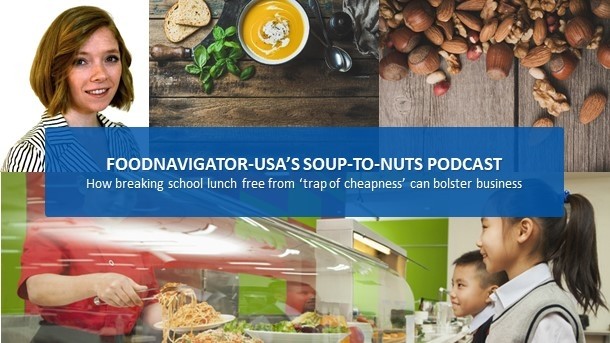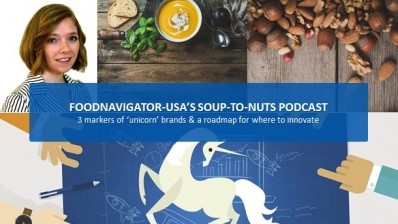Soup-To-Nuts Podcast: How breaking school lunch free from ‘trap of cheapness’ can bolster business

In The Labor of Lunch, Gaddis takes a deep dive into the development and evolution of the National School Lunch Program in the US, which is expected to operate as a financially self-sustaining ‘business,’ unlike other aspects of public schools that are paid for by taxpayers as a shared investment in the future.
This model, which Gaddis argues, “was never ideal,” has forced many schools to prioritize the cost of food over quality. In her book, and this episode of FoodNavigator-USA’s Soup-To-Nuts Podcast, Gaddis explains how this decision negatively impacts the health of children, strains cafeteria workers and reinforces socio-economic discrimination that in turn further restricts program funding and creates a “trap of cheapness.”
She also outlines several potential solutions, which she calls on legislators, schools, parents and the food and beverage industry to enact to not only improve the quality of food offered through the National School Lunch Program but also the long-term health of children and quality of life for those who serve them.
[Editor’s note: Never miss another episode of FoodNavigator-USA’s Soup-To-Nuts Podcast. Subscribe on iTunes.]
The impetus and evolution of the National School Lunch Program
As Gaddis explains in her book The Labor of Lunch, the roots of the National School Lunch Program are grounded in good intentions to provide nutrition to children and bolster the macro-economics of farming. However, she adds, these good intentions have paved the way for unintended negative consequences.
“Most people will tell you the National School Lunch Program started in 1946 … to serve two purposes. One is to safeguard the health and wellbeing of the nation’s children by providing nonprofit school lunches made with nutritious food, and then the other purpose is to basically provide an outlet for commodity foods that the US government needs to support,” Gaddis said.
But, she added, it actually began decades earlier when women concerned about food safety and providing proper nutrition organized a school lunch program to offer meals in the school building so that students would not need to bring their own food, and risk it spoiling before lunch, or purchase it from street vendors.
The expansion and devolution of the school lunch program
Since the program launched, Gaddis notes, it has expanded to 95% of public schools and serves about 30 million children daily – most of whom come from poor families led by single mothers. And while on the surface this may sound like a success, Gaddis argues that the way the program concentrates on children most in need, rather than all children, is hugely detrimental both to the program as a whole and those it serves.
Specifically, she argues, the National School Lunch Program inadvertently is reinforcing socio-economic discrimination in a way that shames children and discourages those who can afford another option to opt out of the program. This, in turn, further limits the funds available to the program and makes balancing the cost and quality food even more difficult for administrators – ultimately creating a vicious downward cycle.
She explains that the vast majority of students who participate in the National School Lunch Program are from families with fewer resources, and while most schools seek to protect who receives a free or reduced lunch, students can easily tell based on what each child is eating and whether or not they can afford to bring a lunch from home or purchase additional a la cart items.
“Because in the US class and race are so highly correlated, I think this also ends up in a lot of school cafeterias as really translating into a racial kind of segregation in terms of what kids are actually eating,” Gaddis said.
“The economics of sorting and segregation that we have within the National School Lunch Program is a big problem because it really, not only makes the cafeteria a place that can be really exclusionary and subject kids to shame and stigma, but I think it also creates this situation in which a lot of upper middle class and middle class families end up dropping out of the program. And really reduces the political will to increase the quality of the food and the atmosphere for all kids,” she said.
Breaking free of a broken paradigm
The issue of “lunch shaming” has generated several high profile headlines in recent past years and inspired many individual and companies, including Chobani, to pay off the debt so that children can continue to eat and participate in school activities. But while these donations are laudable, Gaddis argues they should not be necessary, and that in a sense they are letting the “government off the hook.”
A better solution is to create a new model that is more inclusive of everyone, and which is not caught in a “paradigm of cheapness,” she argues.
She explains that if the National School Lunch Program actually fed all students, schools would have much more money to negotiate higher quality food. As it is though, she explains, those who are turned off by the current quality and can afford to opt out of the program actually reduce the amount of money schools have to buy food, forcing them to downgrade their purchases.
As constricting as this may sound, Gaddis notes that schools can break free of this paradigm and improve the quality of the food they serve in part by better educating parents about what is possible if more children participate in the program – even if just one or two days a week.
Seizing opportunities for improvement
Money is not the only hurdle hindering schools’ ability to offer higher quality meals. According to Gaddis, many schools have limited physical capabilities to prep food, which is creating an opportunity for food and beverage manufacturers to step in and act as the middle man for prep or offer cleaner finished products.
She notes that many companies – especially smaller startups – already are rising to this challenge based on what she has seen at the School Nutrition Association Annual Food Show in recent years. But, she also notes, there is still room for improvement.
In recent years, Gaddis said, she has noticed big food companies launching higher quality tiers of food – such as ‘clean label’ chicken nuggets – that schools can purchase at a premium. However, not all schools can afford this premium – reinforcing the current structure. However, Gaddis said, if manufacturers were to roll out new technology across all categories then all schools could benefit.
Gaddis also encourages manufacturers to look for ways to innovate at a regional – not just national – level so that they can help schools better tap into local food.
She also calls on food companies to differentiate themselves from their competition by implementing programs that improve worker welfare in schools and also across their supply chain. While she recognizes this is a potentially daunting call to action, she says that companies that answer it will be rewarded by parents who want to buy products from corporations that “do good.”
Beyond manufacturers, Gaddis calls on legislators and their constituents to support the Universal School Meals Program Act, which was introduced in October by Sen. Bernie Sanders (I-Vt.) and Ilham Omar (D-Minn.) and would, if passed, reduce the stigma and lack of inclusivity in the National School Lunch Program. It also would allow school districts to bolster their food education programs, increase the reimbursement rate and potentially source more ingredients locally.
And finally, Gaddis calls on students in her book to advocate for changes to the lunch program that address climate change and social justice issues to create a more sustainable food system in the long-term.

















